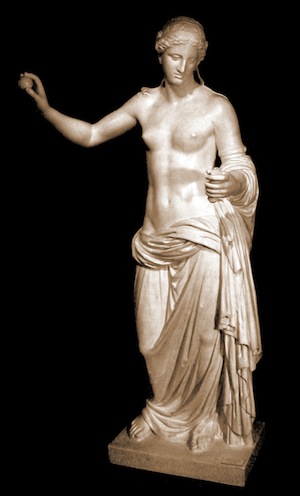Classical Greek Sculpture

Aphrodite of Arles
Classical Greek
replica: from the Louvre, Paris
gift of: Turhan Okeren
date of the original: 4th century BC
provenance of the original: found in 1651 in the area of the Roman theatre of Arles, France; now in the Louvre, Paris
description: Standing, partially draped figure of Aphrodite. Round object in right hand, which is raised, handle of mirror in her left. Plaster replica; marble original. Height 210 cm, width 95 cm, depth 51 cm.
The Aphrodite of Arles is a Hellenistic copy of a prototype attributed to Praxiteles (see also: Hermes and the Infant Dionysus; Apollo Lykeios; Aphrodite of Cnidos), hence its fourth century date. A reference in Pliny the Elder may refer to the original of this work--the first known statue of the goddess with the upper body naked. This Aphrodite recalls the form of the Aphrodite of Cnidos and is a heavier, less refined ancestress of the Aphrodite of Melos (see also: Aphrodite Anadyomene; Crouching Aphrodite).
The head of the original was found broken from the torso and the arms were missing. It was restored by the French sculptor François Girardon, who was commissioned by King Louis XIV (see also:Hannibal). Girardon gave the statue a mirror in the left hand and an apple in the right, which may not have been part of the original at all, but catered rather to royal preferences. The mirror is a traditional sculptural device meant to illustrate Aphrodite’s attribute as the goddess of beauty, while the apple represents the “Apple of Discord”, the catalyst which triggered the Trojan War of Homeric epic.